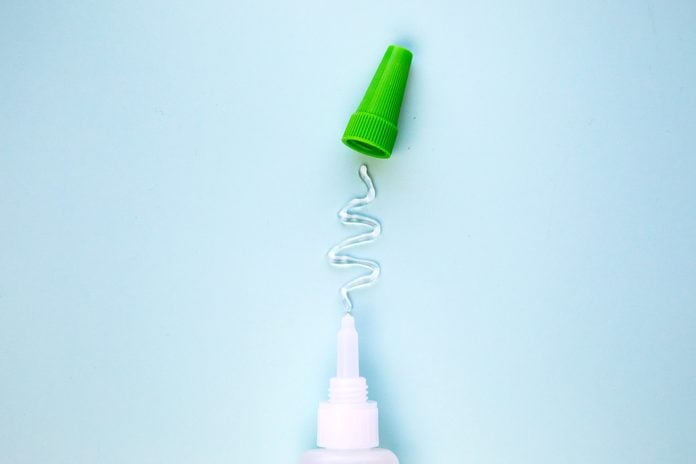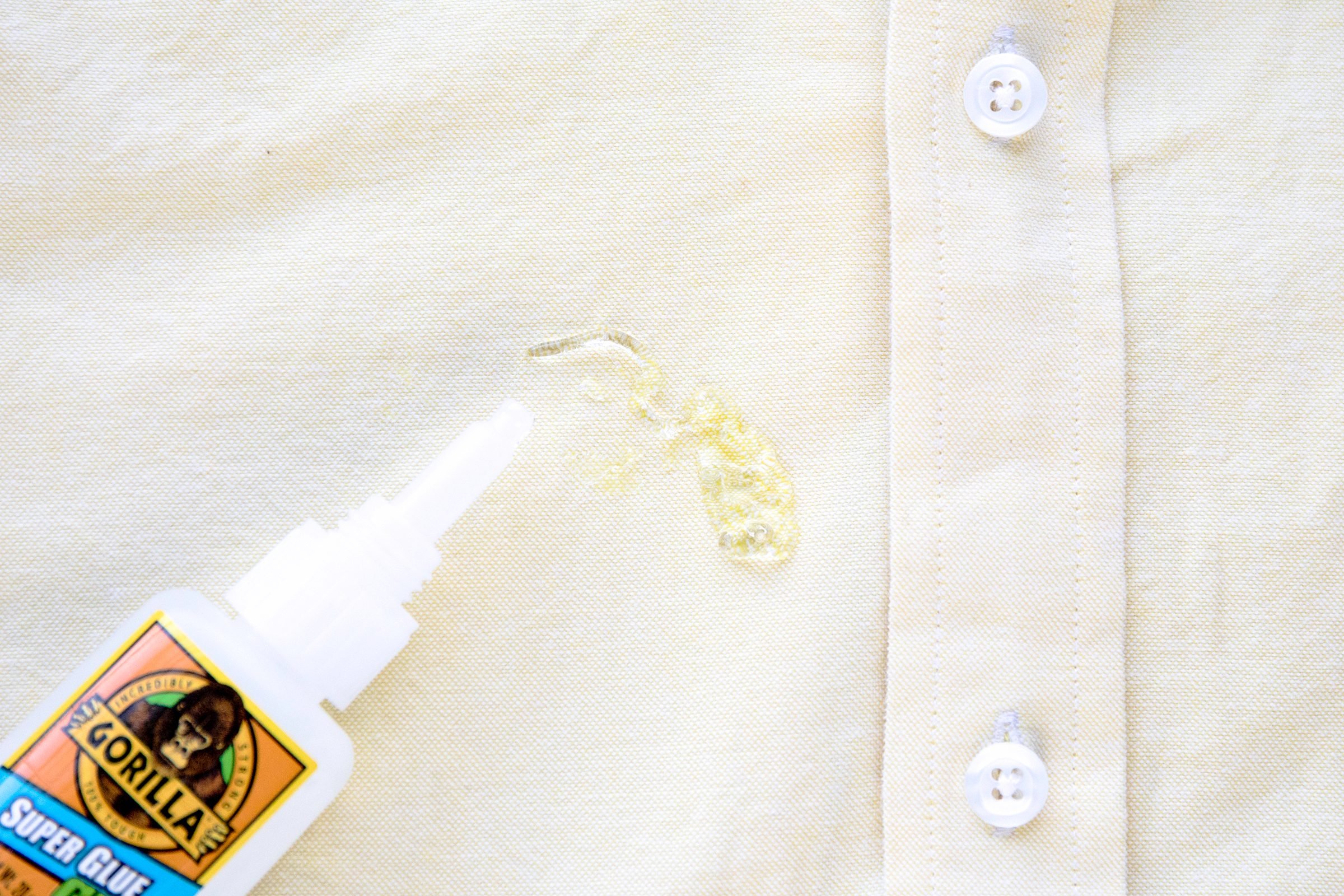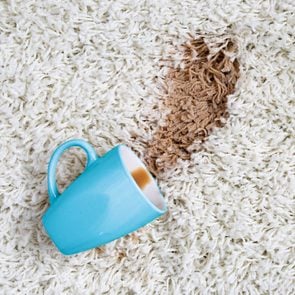How to Remove Super Glue from Almost Anything
Updated: Mar. 13, 2024

Removing super glue and Gorilla Glue is hard, but not impossible, with these expert tips.
Super glue and Gorilla Glue can be a miracle fix for repairing almost anything—including broken metal, ceramic, leather, rubber, vinyl, and some plastics. Unfortunately, anyone who has ever used ultra adhesive solutions is well aware that how to remove super glue can be incredibly challenging. “Super glue is incredibly difficult to remove because it is extremely strong,” explains Guy Peters, owner and founder, MOP STARS. “It’s so strong, in fact, that a 1-square-inch bond can hold more than a ton!” With strength like that, it’s no surprise that it’s hard to remove.
As if that weren’t alarming enough, there’s also the added complication of how fast it sets. “While most glues take minutes (or longer) to set and create a strong bond, super glue can form a powerful bond in just a few seconds,” Peters points out. This is due to the fact that the chemical reaction that creates the super glue bond requires only a small amount of water. And water is everywhere—on our hands, the surface we’re gluing, and even in the air in the form of humidity. “This is what helps super glue create a strong bond in only a few seconds and a big reason why this stuff can be so hard to remove,” he explains. While some Gorilla Glue formulas have different main ingredients, it works the same way, setting in less than a minute with a similar level of strength.
Acetone, the go-to ingredient for removing nail polish and also one of the best products for removing sticker residue, is also extremely useful for dissolving super glue, “but if you are not careful you may end up removing more than you bargained for,” warns Peters. “That’s because while acetone is a great solvent for super glue, it can also remove the finish from wood, paint off walls, dissolve plastics, and even damage some fabrics.” So while acetone will do the trick, you also need to consider the surface you’re working with. Additionally, acetone is also extremely flammable, so you need to use it with caution.
What it boils down to when it comes to how to remove super glue will generally depend on the type of surface you are trying to get it off of. For example, if you are trying to get super glue off your gorgeous hardwood floors and you opt to use acetone—one of the more popular solutions—you could end up removing your finish too. Follow these hints for how to remove stains that seem impossible to get out (but aren’t).
What removes super glue?
As previously explained, when choosing how to remove super glue, it will primarily depend on the surface. However, here is a list of items that will do the trick.
- Nail polish remover
- Acetone
- Rubbing alcohol
- Hand sanitizer
- Sandpaper
- White vinegar
- Soapy water (for skin)
- Olive oil (best for skin or small amounts)
- Lighter fluid
- Nitromethane
How to get super glue off skin
While there are dozens of “hacks” for how to remove super glue off your skin, according to the folks at The Original Super Glue, the best way to pull it off is just with soap and water. Here’s how:
-
Vigorously apply warm soapy water to the area. “The soap can help break up the bond a little but it will take time,” explains Peters.
-
Consider scrubbing the area with a sponge or washcloth but be gentle and use light pressure.
-
Continue light scrubbing until the glue starts to slowly flake off. “Use caution with large pieces as you do not want to accidentally pull the skin off with,” he advises. “Remember, this stuff is strong so be prepared to go through a couple of washing cycles.”
How to remove super glue from glass
The good news when it comes to removing super glue from glass is that it is pretty durable, so you shouldn’t have any problem using any of the more powerful solvents on this list to remove super glue. Peters maintains that your best option is going to be acetone/nail polish remover followed by rubbing alcohol-based products. Lighter fluid—which can also help remove nail polish from certain surfaces—is also an option.
Here’s how to do it:
-
Apply the solvent (acetone, nail polish remover, rubbing alcohol, etc) to a cotton ball or cloth or possibly a sponge if you’re working with sturdier glass.
-
Blot the area and make some circles with vigorous pressure.
-
If it doesn’t come off right away, allow it to sit for several minutes.
-
Repeat as needed.
How to remove super glue from plastic
Plastic is certainly one of the tougher materials to remove super glue from, according to Peters. “The big problem is that many of the solvents (especially acetone) that remove super glue will also dissolve, damage, and possibly even destroy the plastic,” he explains. “If you’re dealing with a sturdy plastic or only a little bit of super glue, you can get away with only a little acetone. But if you’ve got a bigger super glue problem you might need to get a bit more creative.”
According to the folks at Krazy Glue, the best option is something called nitromethane, available in some specialty hobby stores; you can also find some super solvents with similar ingredients online, such as this Satellite City Super Solvent.” Just be aware that there are many kinds of plastics, and they can all react a little differently, so always start with a hidden or non-critical area before trying any method,” Peters cautions.
 How to get super glue out of clothes
How to get super glue out of clothes
Acetone can be pretty harsh on many fabrics so it’s usually best to avoid it when it comes time to remove super glue from clothing. Instead, Peters maintains that rubbing alcohol will work for fabrics like cotton and polyester. “Even wool can handle some rubbing alcohol but leather will require a different approach,” he adds.
For leather, consider using vinegar since it can be much less harsh but still effectively remove the super glue. “You might need to give it more time than some other compounds and work it in a bit more vigorously but it should get the job done,” says Peters.
Another, more surprising option? WD-40. “The WD-40 loosens up the glue so it can be removed. But the reason this option is one of my favorites is that WD-40 is actually good for leather in general and can be used to soften it up,” Peters reveals. So not only can you remove the glue but you can also give your leather a bit of a tune-up. Learn more unusual uses for WD-40.
Whether you’re using rubbing alcohol, vinegar, or WD-40, apply a small amount to a clean cloth and scrub vigorously until the super glue starts to come off.
How to get super glue off upholstery and carpet
Removing super glue from upholstery will depend on the type of fabric, but for the most part acetone should be avoided for most fabrics and carpets. “Acetone can wash out color from carpet so you could go from a stiff spot of super glue to a bleached out circle,” Peters points out. Instead, rubbing alcohol makes the best option here and most carpets can handle it without issue. But as always, test a hidden spot first. He also suggests avoiding items like vinegar for carpets since it could easily soak in and you’ll be left with the smell for quite some time. Learn some strategies for removing nail polish from carpet.
How to remove super glue from metal
Metal is usually one of the easier items to remove super glue from as metals are tough enough to withstand acetone without issue, according to Peters. “Just be careful when applying the acetone that you don’t get it on another nearby material.”
How to remove super glue from wood
The first thing to consider is whether or not the wood is finished or unfinished. “Unfinished wood is easy—just apply our trusty acetone,” Peters says. However, finished wood is a little trickier because the acetone can actually remove the finish. “Not only will this end up looking strange but it could impact the life of the wood,” he explains. “If you’re very careful, you can try using a q-tip with acetone on it to apply to the superglue area. This works great for small spots.”
If you don’t want to risk it, try a product with nitromethane. “It’s specifically designed to remove glue and nothing else,” he suggests. You can also try mineral oil which can help loosen up the glue so you can scrape it off.
Other tips for removing super glue
Consider scraping the glue off: Before you attempt removing super glue from your item with a solution, Peters suggests starting by scraping it off. “While this can be a little risky, sometimes the best option is to try and scrape the glue off,” he Peters. “With something pliable like cloth you can stretch and wiggle the fabric to break up the glue.” For harder materials like wood, metal, and some plastics you can scrape the glue off with a razor blade or even sandpaper.
Make use of Q-Tips. Q-tips can be a great way to apply acetone or other solvents to small areas of super glue. “Q-tips will let you get plenty of acetone on the area but there will also be very little risk of using too much,” says Peters. “If you’re careful, you can use this technique to remove glue from sensitive surfaces like plastic and finished wood by only getting the acetone on the actual glue. But be careful!”
Next, bookmark this guide on how to remove permanent marker stains from just about anything.
Sources:
- Guy Peters, owner and founder, MOP STARS
- The Original Super Glue: “Answers to all things The Original Super Glue Corporation”
- Krazy Glue: FAQs



